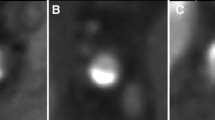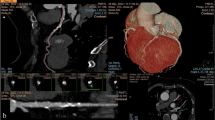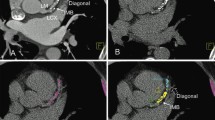Abstract
Background
Multislice computed tomography (MSCT) has started to replace Electron beam CT for quantitation of coronary artery calcium. However no study has evaluated the diagnostic accuracy of MSCT for prediction of coronary artery disease (CAD) in a symptomatic patient population using the volume score.
Methods and Results
1347 symptomatic subjects (male = 803, mean age = 62 years) with suspected CAD underwent MSCT studies 1 ± 2 days before the coronary angiogram. The Agatston (ACS) and Volumetric calcium score (VCS) were calculated using a proprietary workstation. Statistical analyses included the Pearson’s correlation coefficient and the nonparametric Mann–Whitney U-test to compare the calcium score in different age groups and between men and women. Sensitivity, specificity and predictive accuracy were calculated for different calcium thresholds for prediction of CAD. ROC curve analyses were used to establish relations between the coronary calcium score and presence or absence of CAD. In 720 (53%) subjects (male = 419) angiography revealed a minimal lumen diameter stenosis greater than 50%. Patients with significant CAD had significantly higher total calcium score values than patients without CAD (P = 0.001). ACS and VCS demonstrate a close correlation for the whole study group, r = 0.99. The overall sensitivity of any calcium to predict stenosis was 99%, specificity = 32%. Exclusion of calcium was highly accurate for exclusion of CAD in subjects older than 50 years (predictive accuracy = 98%). An absolute cutoff >100 and an age and sex specific threshold (score over 75th percentile) were identified as the cutoff levels with the highest sensitivities (86–89%) and lowest false positive rates (20–22%). ROC analyses revealed MSCT calcium scanning as a good clinical test which can be performed with similar accuracy in all age groups with an area under the curve of 0.84.
Conclusion
Determination of coronary calcium with MSCT is an accurate imaging modality for prediction of significant CAD in a patient population with intermediate likelihood of CAD. Exclusion of any calcium provided strong evidence that patients older than 50 years did not have obstructive CAD. ACS and VCS show an equivalent diagnostic accuracy.




Similar content being viewed by others
References
Sangiorgi G, Rumberger JA, Severson A et al (1998) Arterial calcification and not lumen stenosis is highly correlated with atherosclerotic plaque burden in humans: a histologic study of 723 coronary artery segments using nondecalcifying methodology. J Am Coll Cardiol 31:126–133
Budoff MJ, Diamond GA, Raggi P et al (2002) Continuous probabilistic prediction of angiographically significant coronary artery disease using electron beam tomography. Circulation 105:1791–1796
Arad Y, Spadaro LA, Goodman K, Newstein D, Guerci AD (2000) Prediction of coronary events with electronbeam computed tomography. J Am Coll Cardiol 36:1253–1260
Callister TQ, Raggi P, Cooil B, Lippolis NJ, Russo DJ (1998) Effect of HMG-CoA reductase inhibitors on coronary artery disease as assessed by electron-beam computed tomography. N Engl J Med 339:1972–1978
Kondos GT, Hoff JA, Sevrukov A et al (2003) Electron-beam tomography coronary artery calcium and cardiac events. A 37-month follow-up of 5635 initially asymptomatic low- to intermediate-risk adults. Circulation 107(20):2571–2576
Ohnesorge B, Flohr T, Becker C et al (2000) Cardiac imaging by means of electrocardiographically gated multisection spiral CT: initial experience. Radiology 217:564–571
Stanford W, Thompson BH, Burns TL, Heery SD, Burr MC (2004) Coronary artery calcium quantification at multi-detector row helical CT versus electron-beam CT. Radiology 230:397–402
Becker CR, Kleffel T, Crispin A et al (2001) Coronary artery calcium measurement: agreement of multirow detector and electron beam CT. AJR Am J Roentgenol 176:1295–1298
Knez A, Becker C, Becker A et al (2002) Determination of coronary calcium with multi-slice spiral computed tomography: a comparative study with electron-beam CT. Int J Cardiovasc Imag 18:295–303
Janowitz WR (2001) Current status of mechanical computed tomography in cardiac imaging. Am J Cardiol 88(Suppl):35E–38E
Budoff MJ, Mao S, Zalace CP, Baksheshi H, Oudiz RJ (2001) Comparison of spiral and electron beam tomography in the evaluation of coronary calcification in asymptomatic persons. Int J Cardiol 77:181–188
Schmermund A, Erbel R, Silber S (2002) Age and gender distribution of coronary artrey caclium measured by four-slice computed tomography in 2.030 persons with no symptoms of coronary artery disease. Am J Cardiol 90:168–173
Flohr T, Ohnesorge B (2001) Heart rate adaptive optimization of spatial and temporal resolution for electrocardiogram gated multislice spiral CT of the heart. J Comput Assist Tomog 25(6):907–923
Kopp AF, Schroeder S, Kuettner A et al (2001) Coronary arteries: retrospectively ECG-gated multi-detector row CT angiography with selective optimization of the image reconstruction window. Radiology 221:683–688
Jakobs TF, Becker CR, Ohnesorge B et al (2002) Multislice helical CT of the heart with retrospective ECG gating: reduction of radiation exposure by ECG-controlled tube current modulation. Eur Radiol 12:1081–1086
Callister TQ, Cooil B, Raya SP et al (1998) Coronary artery disease: improved reproducibility of calcium scoring with an electron-beam CT volumetric method. Radiology 208(3):807–814
Begg CB, Gremes RA (1983) Assessment of diagnostic test when disease verification is subject to selection bias. Biometrics 309:207–215
Carr JJ (2001) Coronary calcium: the case for helical computed tomography. J Thorac Imag 16:16–24
Rumberger JA (2001) Tomographic (plaque) imaging: state of the art. Am J Cardiol 88:66E–69E
O’Rourke RA, Brundage BH, Froelicher VF et al (2000) American College of Cardiology/American Heart Association Expert Consnesus document on electron-beam computed tomography for the diagnosis and prognosis of coronary artery disease. Circulation 102:126–140
Nasir K, Budoff MJ, Post WS et al (2003) Electron beam CT versus helical CT scans for assessing coronary calcification: current utility and future directions. Am Heart J 146:969–977
Hoff JA, Chomka EV, Krainik AJ, Daviglus M, Rich S, Kondos GT (2001) Age and gender distributions of coronary artery calcium detected by electron beam computed tomography. Am J Cardiol 87:1335–1339
Knez A, Becker A, Leber A et al (2004) Relation of coronary calcium scores by electron beam tomography to obstructive disease in 2,115 symptomatic patients. Am J Cardiol 93:1150–1152
Haberl R, Becker A, Leber A et al (2001) Correlation of coronary calcification and angiographically documented stenoses in patients with suspected coronary artery disease: result of 1,764 patients. J Am Coll Cardiol 37:451–457
Bielak LF, Rumberger JA, Sheedy PF, Schwartz RS, Peyser PA (2000) Probabilistic model for prediction of angiographically defined obstructive coronary artery disease using electron beam computed tomography calcium score strata. Circulation 102:380–385
Author information
Authors and Affiliations
Corresponding author
Rights and permissions
About this article
Cite this article
Becker, A., Leber, A., White, C.W. et al. Multislice computed tomography for determination of coronary artery disease in a symptomatic patient population. Int J Cardiovasc Imaging 23, 361–367 (2007). https://doi.org/10.1007/s10554-006-9189-1
Received:
Accepted:
Published:
Issue Date:
DOI: https://doi.org/10.1007/s10554-006-9189-1




